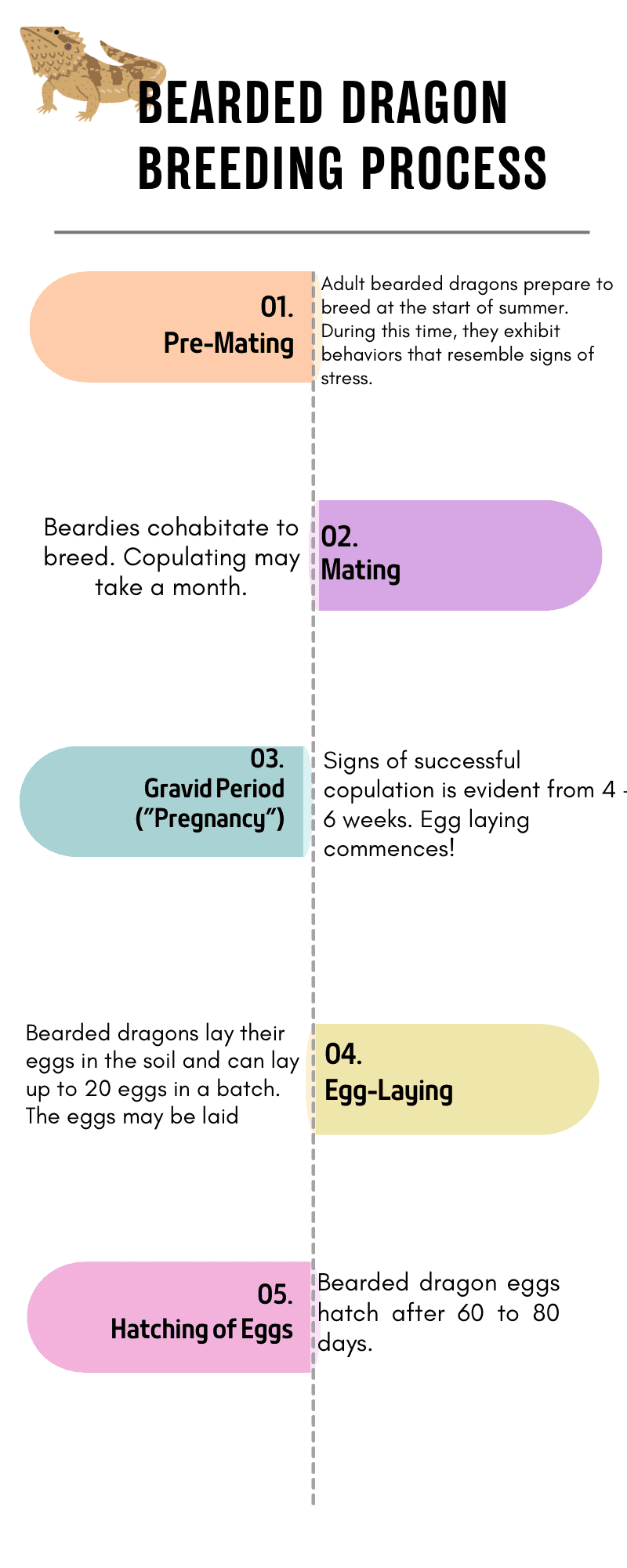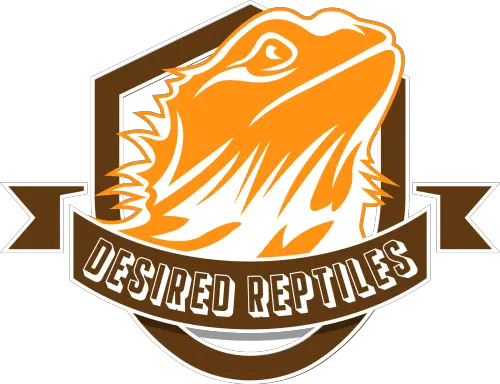Bearded dragons undergo several steps to successfully bear offspring. What might seem simple to us is a complex and demanding process for them. During this time bearded dragons are vulnerable, which is why you must fully understand the process.
Bearded dragons mate by aligning their cloacas (reproductive opening) after mounting. This process lasts only a few minutes, but it may take several tries over time to achieve pregnancy.
How Bearded Dragons Breed In Simple Terms
If you’re planning to breed your bearded dragons, you must be properly prepared for the entire process. Beardies go through several steps to propagate, and in captivity, require assistance for a safe and successful procedure. The image below illustrates the operation in summary:

In this article, I’ll take you through the bearded dragon mating process to help you prepare your pet for successful baby-making. Without further ado, let’s get into it!
The Pre-Mating Process: Preparing Your Bearded Dragon for Copulation
The pre-mating period is crucial in determining whether your pets are compatible or ready to reproduce, and also in preparing you for the task ahead. Here’s how to go about it:
Plan Sufficiently
Ensure you have the time, space, and money to house over 10 baby dragons, or at least, have re-homing options in your inventory. Breeding bearded dragons can be challenging, and I’ve witnessed people burn out before the eggs even hatch, only to face a fresh set of hatchling responsibilities.
Identify Your Beardie’s Sex
Bearded dragons are monomorphic in nature making it tricky to differentiate between male and female. They are often mistakenly identified as the wrong sex until breeding is discussed.
To know your pet’s sex, lift the tail and look for tiny swells (hemipenal bulges) at the base of the cloaca. If you see two bumps side by side, it’s a male; if there are none, it’s a female.
Make Sure Your Pet Is Healthy
Adenovirus is a highly contagious disease that can be passed among bearded dragons during reproduction, often affecting offspring. What’s worse, there’s no known vaccine or cure for the virus! Thankfully, adenovirus is not transmissible from beardie to human, giving you a better chance at containing the ailment. The best way to properly limit the virus’s spread is through safe and healthy breeding.
Feed Your Beardie Healthy Meals
A week prior to and after mating, place the female bearded dragon on a diet rich in vitamin D and calcium to ensure her eggs are well-formed. While it’s not necessary to supplement the male as they don’t lay eggs, providing vitamins may help it regulate stress and maintain strength.
Prepare The Mating Environment
Despite being solitary in nature, bearded dragons will share the same enclosure for about a week to copulate. Therefore, it’s essential to provide enough space including basking and hiding spots to reduce competition. This will significantly lower the chances of violence during their cohabitation, creating a comfortable environment for both dragons to coexist peacefully. Here’s what you need:
- Terrariums: You need two terrariums—one for breeding the male and female, and another for when they’re separated. Preferably, get 120 gallons each to fully accommodate each dragon’s territoriality and safety. For this purpose, you can acquire thrifted aquariums—they are durable and more affordable. Avoid plastic or low-quality tanks as these wear out quickly due to constant heat and may pollute your pet’s environment.
- Proper Lighting: Bearded dragons require a durable UVB and basking bulb for their basic survival. Without adequate lighting and the energy it provides, reproduction can become too burdensome for your beardies to perform.
- Separate Hiding and Basking Spots: Two adult bearded dragons may coexist in the same terrarium, but they will compete over basking spots or sleeping quarters. This contest can become dangerous, often causing the weaker bearded dragon stress or worse.
When Do Bearded Dragons Mate?
Bearded dragons mate during the summer. Depending on where you’re situated, it could be at any time of the year. Australian summer starts from December to February and can get over 100°F. The increased heat and abundant daylight make it ideal for wild beardies to hatch their offspring, a pattern that is often observed even in captivity.
During warmer and shorter nights, beardies may begin to display mating behaviors such as stomping, bobbing, waving, or even digging in female beardies.
The Actual Bearded Dragon Mating Process & Patterns
To initiate mating, put both sexually mature female and male bearded dragons in the same terrarium for a week, then separate them for a week, and repeat this cycle for 3 to 4 weeks. The male beardie will chase after the female, mount her, and align their cloacas.
Both dragons may show signs of stress during this time, such as head bobbing and darkening beards. They may also injure themselves as mating can become aggressive, which is why it’s necessary to separate them after some time.
| Normal Mating Behavior | Abnormal Mating Behavior |
|---|---|
| Head bobbing, stomping, waving, and darkening beards are highly common | Limping or lying in rather unusual positions |
| Males actively chase females for a chance to mount which can lead to mild scratches | Excessive fighting often ending in serious injuries |
| Cloacas aligning during mating process | Excessive fighting often ends in serious injuries |
| Males bask in higher spots while females become more submissive and slightly avoidant | Extreme avoidance or lack of interest among bearded dragons |
| Slight weight loss and increased resting durations | Lethargy and immense weight loss |
Caring For Your Bearded Dragon After Breeding
After your bearded dragons have successfully mated, you can expect the female to lay eggs. Here are three steps to ensure your female beardie lays her eggs safely:
1. Ensure Your Female Beardie Is Gravid
You can determine if your beardie is heavy with eggs about 4 to 6 weeks post-mating. Her belly will appear lower than usual, and by the 5th week, you may see egg imprints. If she hasn’t grown in size after the 6th week, the mating was likely unsuccessful.
2. Provide a Lay Box
Bearded dragons bury their eggs, so it’s essential to offer a suitable lay box. Use a plastic container filled with roughly 3 inches deep of vermiculite soil so she can dig and lay her eggs comfortably.
3. Have an Incubator Ready
An incubator is crucial for hatching beardie eggs and is not the same as the lay box. An incubator (view on Amazon) imitates the ideal temperature and humidity for your bearded dragon eggs to develop. They typically take about 60 days to hatch, however, this can vary by a few days. Hatching may occur over a span of three weeks, so check on the eggs regularly to ensure new hatchlings don’t disturb the unhatched eggs.
When and How Does a Female Beardie Lay Her Eggs?
Around the 4th week post-mating, your female may show signs of distress, such as running around, head bobbing, and digging. When you notice these behaviors, quickly place her in the lay box and wait a few hours.
Beardies usually lay eggs in the evening or at night, digging into the soil to deposit their eggs and burying them afterward. They can lay about 20 eggs in one sitting, which can take 15 to 30 minutes. Sometimes, eggs may be laid in a span of weeks if they develop at different rates.
Be cautious—bearded dragons are not the best parents as they may eat their eggs if they remain in sight for too long.
How to Successfully Incubate and Hatch Bearded Dragon Eggs
Now that the eggs have been laid, the next step is incubation. Here is a step-by-step process of how to incubate your beardie eggs:
- Do Not Rotate or Disturb the Eggs: Carefully remove the eggs from the lay box without rotating them. Mark the top of each egg with an ‘X’ to avoid turning them upside down. Beardie eggs have an air sac positioned to keep the yolk(embryo) safe from suffocation. If you mishandle the eggs, they can become null and rot.
- Transfer the Eggs to the Incubator: Place the eggs in a properly regulated incubator that can maintain a stable temperature and humidity around the eggs. This step is delicate as sudden changes in condition can jeopardize the hatching process.
- Fix the Proper Temperature and Humidity: Set the incubator to 84°F with 80% humidity for optimal hatching conditions. If your incubator is manually adjustable, check it regularly to ensure the temperature remains stable.
- Keep Track of The Parameters: Use an analog thermometer to monitor the temperature in the incubator for more accurate results. Although there’s an inbuilt thermostat, it’s necessary to observe the temperature and humidity exactly where the eggs are buried to ensure consistency.
- You Mustn’t Hatch All The Eggs: If you’re unsure of how to house and care for 20 baby bearded dragons, select a number you can care for—be it two or three—and proceed with incubating that number of eggs. Place the remaining eggs in a container and freeze overnight before disposal.
Ethical Concerns—Should You Breed Bearded Dragons?
Sadly, it’s almost impossible to ethically breed bearded dragons and still earn financial gain. Since bearded dragons became prevalent, it has become increasingly difficult to avoid financial losses as supply outweighs demand.
The most requested bearded dragons are heavily inbred and genetically modified, which are sometimes unethical.
Many breeders rely on inbreeding to produce visually appealing morphs, often sacrificing qualities that are essential for the bearded dragon’s survival. Silkbacks are a prime example of unethical breeding practices. These scaleless bearded dragons struggle to bask as the heat is often too harsh for their fragile skin, making them less capable of thriving in their natural habitat.
Additionally, silkbacks tend to be more fragile and have reduced cognitive abilities compared to their scaled counterparts. Despite these setbacks, they’re widely sought for their vivid patterns and colors due to their lack of scales.
Wrapping It Up
Breeding bearded dragons is generally straightforward but can quickly become burdensome. It’s manageable with the right information and preparation. Remember to be patient with your beardies, as breeding can also be stressful for them. By following the steps outlined in this article, your bearded dragon will be safely and successfully bred in 4 to 5 months. Good luck!
